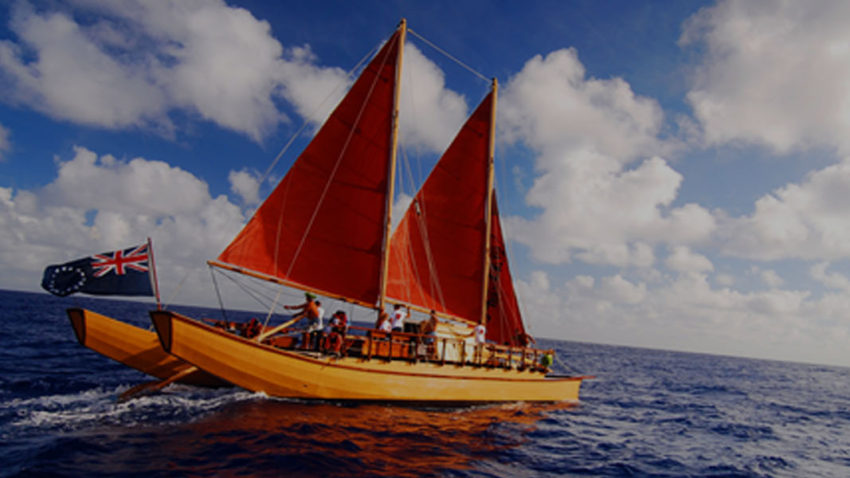Geography
The Cook Islands consist of 15 islands scattered over some 2 million square kilometres of the Pacific Ocean. They lie in the centre of the Polynesian Triangle, flanked to the west by the Kingdom of Tonga and the Samoa’s and to the east by Tahiti and the islands of French Polynesia. The capital island of Rarotonga, lies directly south of Hawaii and is the same distance south of the equator as Hawaii is north. The Cook Islands is just to the east of the International Date Line and is ten hours behind Greenwich Mean Time.
History
The islands are first thought to have become inhabited sometime between 500 and 800 AD, by people from islands in what is now known as French Polynesia. They came in great double-hulled canoes, navigating by using familiar stars, wave movements and temperature differences. These colonizers were believed to have been the last wave of the Polynesian Migration from Asia that began in 1500BC.
The first record of Europeans in the Cook Islands came in the late 16th Century with the Spanish explorer Alvaro de Mendana sighting the Northern Group island of Pukapuka on August 20, 1595. Another Spaniard Pedro Fernandez de Quiros stopped for provisions in Rakahanga on March 2, 1606. After this there is no further record of European contact for 150 years, until Captain James Cook explored the group in his expeditions of 1773 and 1777. In spite of the islands eventually becoming the namesake of the great navigator, Cook personally only went ashore on the then uninhabited island of Palmerston. Remarkably, Cook also never sighted the largest island, Rarotonga: That honour was left to the mutineers on HMS Bounty, who landed on Rarotonga in 1789, during their escape to Pitcairn. Cook had named the group the Hervey Islands, after a British Lord of the Admiralty, but they were renamed Cook Islands, in honour of the great explorer, some 50 years later by the Russian cartographer, Admiral Adam Johann von Krusenstern.
European settlement in the Cook Islands began with the arrival of the famed Reverend John Williams of the London Missionary Society, who landed in Aitutaki in 1821 and then on to Rarotonga in 1823, and who, with the assistance of various other missionaries, succeeded in converting the natives to Christianity.
On October 26, 1888, Captain Edmund Bourke of the British Admiralty hoisted the British Flag on Rarotonga and other islands of the Southern Group and declared the islands to be part of the British Dominions. Subsequently an Imperial Order in Council in the New Zealand Parliament on May 13, 1901, permitted the annexation of the Cook Islands to New Zealand and came into effect on June 11, 1901, following a discussion with the Paramount Chiefs MAKEA and NGAMARU ARIKI as well as others. On August 4, 1965, after adoption of a Report by the Cook Islands Legislative Assembly, the Administrator of the Government of New Zealand at the time signed the Proclamation to declare the Cook Islands a Self Governing State.
The Client agrees to –
1. provide proof, by way of deletion certificate, that the vessel ceases to be registered in any other State on any other Register;
2. if a charter registration, provide proof of suspension of registration from the underlying flag; consent of the owner and a copy of the charter agreement, where the vessel is to be registered as a demise charter registration;
3. establish and maintain themselves as a “Qualified Person” under s 2 of the Cook Islands Ship Registration Act 2007;
4. submit to the Registrar all information related to, but not limited to survey, certification, crew, management, operations and any additional information that may be deemed to be relevant or requested from time to time;
5. notify the Registrar immediately of any changes relating to ownership, management, ISM management of any of their vessels or any other changes that may be deemed to be relevant;
6. notify MCI immediately of any accidents, incidents or mishaps to vessel, crew or passenger; by completing relevant incident reports, notifying a Deputy Registrar, Maritime Cook Islands approved surveyor
7. ensure the vessel is operated and maintained in compliance with the relevant IMO and / or Cook Islands national standards that apply to the vessel;
8. ensure that the vessel will not be used in contravention of International law, the law of the Cook Islands or law of another State through which the vessel transits or in which it operates;
9. ensure vessel will not be used in a manner that will be detrimental to the Cook Islands;
10. notify the Registrar immediately of any Port State Control inspection of the vessel;
11. pay all costs associated with a post detention inspection that may be carried out on the vessel by MCI following a Port State Control detention, confirm that all deficiencies have been rectified by submitting the related ISM NCRs and CARs, and that the vessel is being operated and maintained in compliance with International and Cook Islands standards.
12. make the vessel available at a time agreed to with Maritime Cook Islands, for a Flag State Inspection, or any other inspection, as maybe required by the Registrar from time to time;
13. ensure that the vessel is surveyed within the set windows,
14. ensure that NCRs and CARs are submitted to MCI for any deficiencies found during Cook Islands surveys or PSC inspection while flagged with Cook Islands
15. pay all fees due to MCI (including bank fees for international transfers) before the due date;
16. pay any interest due;
17. pay reasonable legal costs (on a solicitor client basis) for MCI to recover any overdue fees, and or bank charges and or interest;
18. pay surveyor fees;
19. maintain P&I cover where applicable (i.e. Bunker; CLC; Wreck removal; MLC etc.)
20. agree to comply with all Maritime Cook Islands procedures as published or otherwise instructed by Maritime Cook Islands
